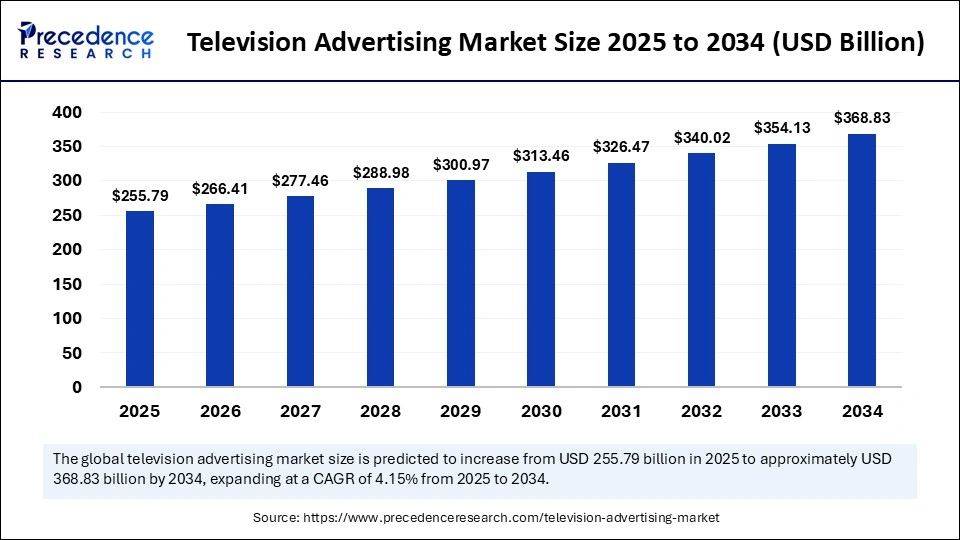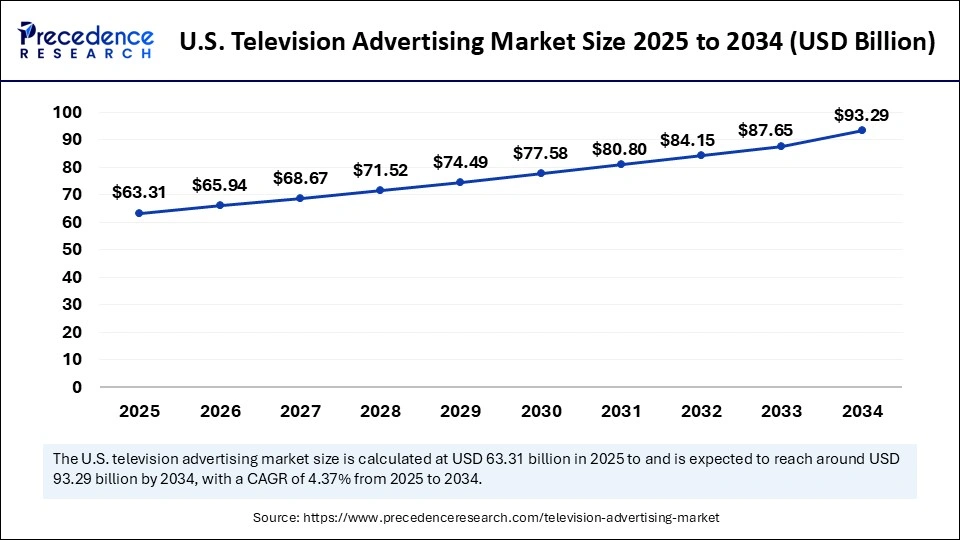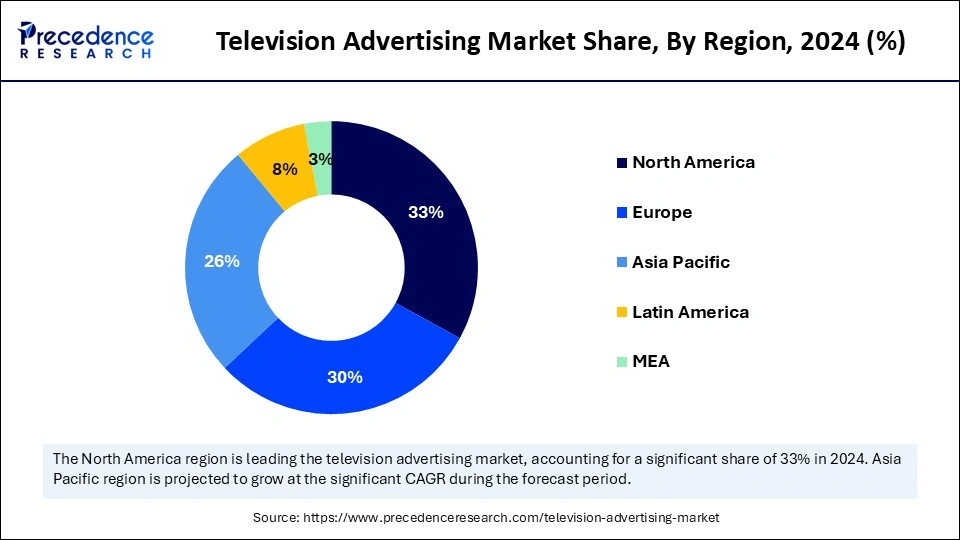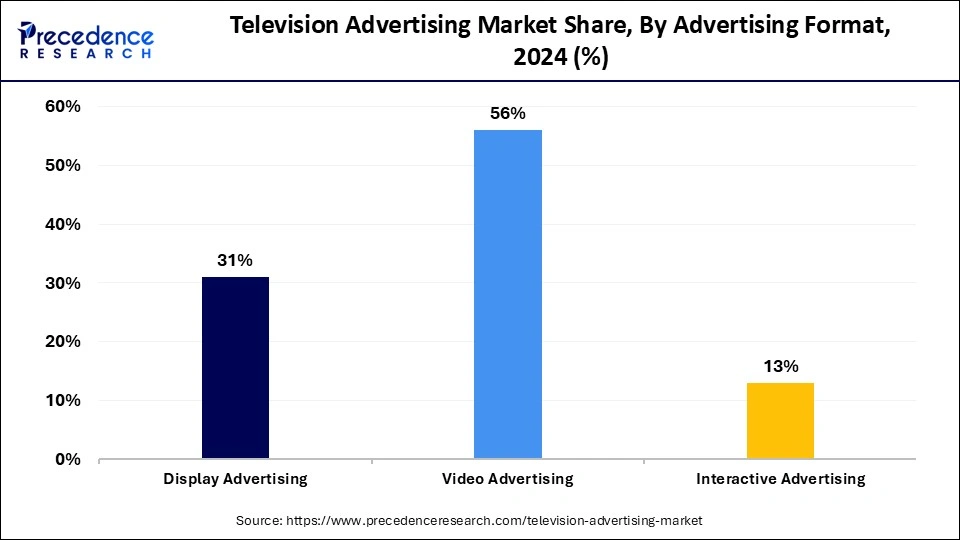List of Contents
Television Advertising Market Size and Forecast 2025 to 2034
The global television advertising market size accounted for USD 245.60 billion in 2024 and is predicted to increase from USD 255.79 billion in 2025 to approximately USD 368.83 billion by 2034, expanding at a CAGR of 4.15% from 2025 to 2034. The growth of the market is attributed to the rising demand for interactive and descriptive advertisements.

Television Advertising Market Key Takeaways
- In terms of revenue, the market is valued at $255.79 billion in 2025.
- It is projected to reach $368.83 billion by 2034.
- The market is expected to grow at a CAGR of 4.15% from 2025 to 2034.
- North America dominated the market with the largest share of 33% in 2024.
- Asia Pacific is expected to grow at the fastest CAGR in the upcoming period.
- By advertising format, the video advertising segment held the major market share of 56% in 2024.
- By advertising format, the interactive advertising segment is projected to grow at the fastest rate between 2025 and 2034.
- By target audience, the mass market segment dominated the market in 2024.
- By target audience, the niche market segment is likely to grow at a significant rate during the forecast period.
- By delivery platform, the broadcast television segment led the market in 2024.
- By delivery platform, the streaming services segment is projected to grow rapidly in the coming years.
Impact of AI on the Television Advertising Market
Artificial Intelligence significantly drives the growth of the market for television advertising because it supports the creative process through analyzing data based on contextual relevance, past interactions, and audience demographics. AI-based solutions support storyboarding, real-time creative adjustments, and ad placement, making it simple for advertisers to test various strategies without physically generating numerous versions of an ad. AI transforms the process of ad production by allowing advertisers to create TV-ready video content from easy inputs of text. It also facilitates the creation of various variations of ads, enabling adjustments in the whole from demographics of the actor to color schemes to subtle changes in frame rate and audio, ultimately reducing the cost and time. AI algorithm brings a novel era into TV advertising where value is provable by precise analysis and measurement. This technology offers enormous amounts of data to find out the target audience, allowing advertisers to make data-driven decisions.
U.S. Television Advertising Market Size and Growth 2025 to 2034
The U.S. television advertising market size was exhibited at USD 60.79 billion in 2024 and is projected to be worth around USD 93.29 billion by 2034, growing at a CAGR of 4.37% from 2025 to 2034.

North America dominated the television advertising market by holding the largest share in 2024. This is mainly due to strong television penetration in North America. Advancements in technology and a strong focus on larger screen sizes and connectivity options further bolstered the growth of the market in the region. Television remains popular in the region, especially for live events. Several North American brands are rising advertising budgets because of a huge and diverse customer base. The region is home to advertising companies such as WPP, Omnicom, Publicis Groupe, Interpublic Group (IPG), and Dentsu, which sustains the region's position in the market.
The U.S. remains a dominant player in the North American television advertising market. The increasing TV audience in the U.S. is likely to drive market growth. There is high demand for targeted advertising, which ultimately leads to increased engagement and greater profits for broadcasters and advertisers. The growing popularity of connected TVs and the growth in the advertising sector further contribute to the growth of the market.
In June 2024, Madhive, a US-based technology company for local Connected Television advertising, announced a definitive agreement to acquire Frequence Inc., the premier omnichannel ad sales enablement and workflow software for local media companies and agencies. This strategic acquisition unites two innovators in local digital advertising, creating a scaled and streamlined platform for national, regional, and local advertisers to deliver precise, geo-targeted messages across streaming TV, search, online video, display, audio, out-of-home, and social.

Asia Pacific is projected to witness the fastest growth during the forecast period. The growth of the market in the region can be mainly attributed to the rising demand for video content. The rising preference for OTT and streaming services creates opportunities in the market. The increasing adoption of TVs significantly boosts the growth of the market. China is a major marketplace due to the rising spending on entertainment. In 2023, about 99.79% of the population in China had access to TVs. There is a high demand for interactive advertising, which propels the growth of the market.
India plays a key role in the Asia Pacific television advertising market. India has a strong infrastructure of broadcasting, primarily led by Prasar Bharati, a public service broadcaster. The increasing adoption of smart TVs and the rising demand for local content are expected to drive the growth of the market in India
Market Overview
The television advertising market is growing rapidly because of the rising solutions to build brand awareness and recognition. TV advertising helps enhance brand perception and establish credibility. Multimedia storytelling combines sight, sound, and motion, enabling brands to make a memorable impact. TV reaches a larger audience than any other traditional medium, like radio and newspaper, which makes it the best solution for delivering ads. In TV advertising, consumers combine visuals, sound, colors, and movement to convey a message. This contributes to an increase in customer retention rates. It allows for creativity and facilitates attaching a personality to the brand and the people behind it.
Television Advertising Market Growth Factors
- The rising demand for effective marketing solutions is likely to boost the growth of the market. Television advertising is the most effective form of marketing that uses both audio and visual mechanisms to transmit messages. This advertising is relevant and captivating to a large audience.
- The rising need of brands to improve identity and reach a broader audience is expected to boost the growth of the market. TV advertising has the potential to reach a broader audience, making it an efficient tool for brands.
Market Scope
| Report Coverage | Details |
| Market Size by 2034 | USD 368.83 Billion |
| Market Size in 2025 | USD 255.79 Billion |
| Market Size in 2024 | USD 245.6 Billion |
| Market Growth Rate from 2025 to 2034 | CAGR of 4.15% |
| Dominating Region | North America |
| Fastest Growing Region | Asia Pacific |
| Base Year | 2024 |
| Forecast Period | 2025 to 2034 |
| Segments Covered | Advertising Format, Target Audience, Delivery Platform, and Regions |
| Regions Covered | North America, Europe, Asia-Pacific, Latin America, and Middle East & Africa |
Market Dynamics
Drivers
Enhanced Targeting and Analytics Capabilities
The adoption of television advertising is increasing due to its advanced targeting and robust analytics capabilities. Advertisers can reach specific audience segments based on demographics, interests, behavior, and geographic location, increasing the relevance and effectiveness of their messages. This precision raises engagement rates and drives higher conversion results. Furthermore, comprehensive analytics and reporting devices provide real-time insights into key performance metrics like impressions, clicks, view-through rates, and conversions. These data-based insights allow advertisers to make informed decisions, optimize campaign performance, and allocate funds more efficiently, collectively contributing to the sustained expansion of the television advertising market.
The industry's first-of-its-kind technology for immersive Connected TV (CTV) ad formats, mCanvasTV, was introduced in January 2025. The mCanvasTV impacts the omnichannel advertising. The innovative tech leverages interactive storytelling to achieve elevated engagement, broader reach, and lead generation for brands, by engaging experiences for audiences globally.
Restraint
Content-Centric Approach Limits Precision and Efficiency of Ads
The content-centric model of TV advertising has become outdated, which limits the growth of the television advertising market. This model relies on a spray-and-pray strategy, where generic messages are broadcast to mass audiences in the hope of reaching a limited number of potential customers. This approach forces advertisers to make assumptions about which channels their target audiences are watching, leading to ineffective ad placements and reduced return on investment.
Opportunity
Recent Advancements in Programmatic Advertising
The increasing popularity of programmatic TV advertising creates a significant opportunity for the television advertising market. This advertising allows automated, data-driven ad selling and buying on various platforms. Unlike outdated TV advertising, which relies on physical negotiations with individual networks, programmatic advertising leverages advanced algorithms, real-time bidding, and AI-based technologies to streamline ad placement. This strategy facilitates access to first-party data, improves targeting precision, and enhances audience reach. As advertisers progressively pursue personalization and efficiency, the demand for programmatic advertising continues to rise.
- In June 2024, Equativ, the global independent ad tech company, announced its merger with Sharethrough, one of the top independent omnichannel ad exchanges. This union aims to establish one of the largest ad marketplaces worldwide, empowering advertisers, media owners, and technology partners to optimize programmatic scale and value.
Advertising Format Insights
The video advertising segment held the largest share of the television advertising market in 2024. This is mainly due to the increased need for video content. Video content enhances brand awareness by providing engaging, memorable pieces that resonate with viewers. Video ads support answering questions about product benefits and features. It reduces fears or other drawbacks that may prevent the consumer from taking action. Video ads are an excellent way to build credibility and trust with the audience.

The interactive advertising segment is projected to grow at the fastest rate during the forecast period. This type of advertising is an ideal way to generate two-way communication with clients. Interactive ads have greater benefits when the requirement is to capture the attention of customers. This advertising enhances consumer engagement. It also lowers the risk of overspending due to poorly coordinated advertising.
Target Audience Insights
The mass market segment dominated the television advertising market in 2024. This is mainly due to the increased need to reach a wider audience. Mass marketing campaigns often reach broader audiences as compared to niche marketing. With these marketing strategies, corporations might avoid using resources to contact customers separately. Mass marketing advertising is an affordable option, enabling organizations to reach a wider audience base regardless of their location.
The niche market segment is likely to grow at a significant rate during the projection period. This market strategy targets a specific segment of the audience, rather than trying to appeal to everyone. A niche market is a significant part of a larger market defined by its exclusive requirements, preferences, and characteristics. Niche marketing supports businesses in building brand loyalty. The rising demand for personalized advertising is likely to contribute to segmental growth.
Delivery Platform Insights
The broadcast television segment led the television advertising market with the largest share in 2024. TV advertising is the oldest and most traditional form of advertising, dating back to the initial days of television. It reaches a large audience and builds awareness of different brands, so it remains the most popular advertising medium. TV advertising has an influential and dynamic strategy of marketing that involves the dissemination and creation of positive messages. Broadcast TV delivers ads to a wide audience base. TV advertisements are used to reach a wider audience, specifically during peak viewing times, making it effective for brand recall and mass communication.
The streaming services segment is projected to grow rapidly in the coming years. The growth of the segment can be attributed to the rising popularity of connected TVs and streaming services. These services save expenses by foregoing a cable TV solution. These services deliver advertisements faster. They provide numerous advantages, including increased engagement, precise targeting, and real-time analytics. Streaming services also provide affordable campaigns, global reach, and personalized experiences.
Recent Developments in the Market
- In March 2025, Universal Ads, the one-stop TV advertising platform simplifying access to the premium video category, and Ramp, the financial operations platform designed to save businesses time and money, announced UA's first-of-its-kind partnership, giving Ramp's 30,000+ consumers access to premium advertising inventory through the novel Universal Ads ad-buying platform.
- In March 2025, ArabyAds, the Middle East's leading digital advertising company, and VIDAA, a global leader in Smart TV operating systems, partnered with Hisense, a global television manufacturing powerhouse.
- In January 2025, Comcast announced Universal Ads, a one-stop TV advertising platform that brings premier media companies together in a strategic partnership to provide easy access to the premium video category.
- In January 2025, Magnite, the largest independent sell-side advertising organization, announced it has strengthened its partnership with Samsung Ads to power programmatic advertising on Samsung TV Plus inventory in Singapore, the Philippines, and Thailand for the first time.
- In February 2024, INVIDI Technologies, the global leader in advanced TV advertising services, partnered with Tata Play, India's leading content distribution and pay TV platform, to introduce targeted advertising on linear TV channels.
Television Advertising Market Companies

- Procter Gamble
- Walmart
- The Coca-Cola Company
- Unilever
- AT
- Verizon
- Toyota
- General Motors
- Meta
- Comcast
- PepsiCo
- Target
- Amazon
- Ford Motor Company
Segments Covered in the Reports
By Advertising Format
- Display Advertising
- Video Advertising
- Interactive Advertising
By Target Audience
- Mass Market
- Niche Market
- Local Market
By Delivery Platform
- Broadcast Television
- Cable Television
- Satellite Television
- Streaming Services
By Region
- North America
- Europe
- Asia Pacific
- Middle East & Africa
- Latin America
For inquiries regarding discounts, bulk purchases, or customization requests, please contact us at sales@precedenceresearch.com
Frequently Asked Questions
Ask For Sample
No cookie-cutter, only authentic analysis – take the 1st step to become a Precedence Research client